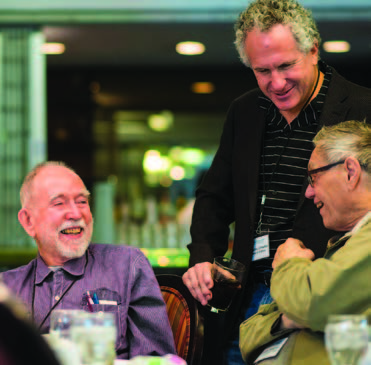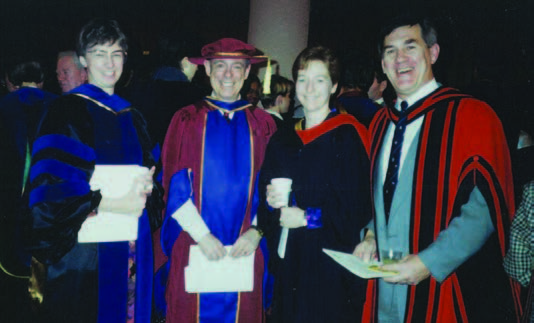In 1908, in his address to the first convocation of the University of Alberta, then president Henry Marshall Tory said, "Our professors are first of all teachers. To them the largest freedom must be given. It is their duty to push into the heart of things that the truth and nothing but the truth may be discovered." ● At that time, there were four such teachers. In the century since, thousands of professors have walked the halls, stood at the front of the class to lecture, spent countless nights in the lab or days conducting research in the field, and donned administrative caps to keep the Faculty of Science moving forward.
Professor Emeritus recognizes meritorious service to the University of Alberta by an individual professor retiring from the university, acknowledging their value due to their record of teaching, research, and community service. The individual must have attained the rank of professor and had at least 10 years of full-time service as a faculty member at the U of A.
There are currently 207 professors emeriti in the Faculty of Science, and it is on the shoulders of these people that we stand today. In their careers, they have touched the lives of many thousands of undergraduate and graduate students, and they have made research contributions both big and small that changed the course of science.
In recognition of these contributions and of the foundation laid by these remarkable individuals, the Faculty of Science hosted an event in September 2017 to celebrate the transformational effects that the emeriti professoriate have had on our students, staff, and faculty, past, present, and future.
Here are the stories of three.
Early game research
When Tony Marsland, now professor emeritus, arrived in the Department of Computing Science in 1970, his English accent earned him the comparison to a Renaissance man by the students. "They expected me to be smoking a pipe and wearing a gentleman's flat cap." Eventually, the students got used to him, and Marsland got used to the students.
"I enjoyed all my classes, but especially the ones where I could 'ad lib.' First-year programming, senior-year operating systems, and any graduate course were especially enjoyable," Marsland recalls. "I spent a lot of time preparing mental notes of points I must make, and hypothetical situations I must explore."
Marsland's research focused on computer chess, which he had been working on since 1968, and led to his active involvement in the International Computer Chess Association. Three early research papers got him going, and over time his research in the field earned him a prestigious McCalla Professorship and recognition by IBM as a Pioneer of Computing in Canada.
Marsland credits a handful of mentors- Bill Adams, John Penney, John Tartar, Arthur Wouk, and Professor Emeritus Keith Smillie-for helping shape him as a professor.
He also recalls some of the students whom he helped guide in turn. "I particularly remember Brian Wesley ('71 BSc, '74 MSc), Wayne Chelak ('71 BSc, '73 MSc), Lorna Gibson ('71 BSc, '73 MSc), Vic Shapiro ('70 BSc, '72 MSc), Murray Campbell ('79 BSc, '81 MSc), Glynis Dorey ('75 BSc), John Demco ('73 BSc, '75 MSc), and Fred Popowich ('82 BSc)," says Marsland. "And of course I am still in touch with my first graduate student, Paul Rushton ('72 MSc)."
A serendipitous encounter
While he was searching for a place to do a post-doc, Bill Samuel, now professor emeritus, found himself reviewing the program at a wildlife disease meeting. A name on the program stood out: John Holmes, now professor emeritus. "I had been at a meeting in Chicago a few months before, and an ecologist told me if I wanted to work with a great parasite ecologist and a great team I should contact John Holmes," says Samuel. Now, he was determined to not let the opportunity slip by.
Holmes and Samuel had dinner, and Holmes offered Samuel the UAlberta Postdoctoral Fellowship. (Jan Muir, another professor emeritus, was the first recipient.) That was all Samuel needed. He packed up his car and made the drive from the U.S., arriving in Edmonton on a snowy autumn day.
Two years into a post-doc, Samuel began to build his name in wildlife parasitology. Near the end of his post-doc, Samuel was called into the office of Bill Fuller, chair of zoology at the time. "He said, 'Well, we have a spot for a big-game person, would you like to stay? I'll give you a few days to think it over.' I said, 'Are you offering me a permanent job? I don't need to think about it; the answer is yes.' And I accepted right on the spot."
Samuel's time in science was spent building a research career in wildlife parasitology, working on big game. His administrative contributions include two stints as associate dean (research) for the Faculty of Science. He was instrumental in setting up the Alberta Conservation Association Grants in Biodiversity, which funds outstanding graduate students in Alberta-based research. The program has awarded more than $5 million to graduate student researchers. He also helped set up the Alberta Conservation Association Endowed Chair, which is currently held by Mark Boyce, professor in the Department of Biological Sciences.
With all of his contributions, Samuel reflects on his greatest thrill. "It was seeing virtually every one of my grad students becoming much more than I ever was and contributing much more than I ever had."
Full circle
For Susan Jensen ('75 PhD), her journey to professor emerita started when she was an undergraduate student in home economics. "I didn't have a family history that would put me into academic work, so I was very unfocused about what I wanted to be," she recalls. "I ended up having to take very rigorous courses in biochemistry and microbiology. It was in that micro course that I first thought, 'I really like this.' Jim Campbell taught that course, and I remember him talking away with a deadpan delivery that was quite funny." Jensen did well in the class, so well that it landed her in the graduate program with none other than Campbell as her supervisor.
"I could see in them things that I imagined in myself. What I most valued in my students was a genuine love or desire to follow the research and answer the question." -Susan Jensen
After graduating, Jensen stayed on in what was then the Department of Microbiology. In the early stages of her career, she was the go-to person to teach whatever was left vacant by a sabbatical or administration leave, often big-enrolment introductory courses. But after she became an Alberta Heritage Scholar, she taught industrial microbiology almost exclusively.
"In the senior courses, some of the students would be aiming for academic or research careers," she says. "I could see in them things that I imagined in myself. What I most valued in my students was a genuine love or desire to follow the research and answer the question."
With the formation of the Department of Biological Sciences in 1994, Jensen took another step in her academic career, becoming the first official chair of the new department in 1995. Her 20 years of financial support for research into the production of antibiotics by an organism called Streptomyces clavuligerus was honoured by the Alberta Heritage Foundation for Medical Research.
In retirement, Jensen still gets together with what is affectionately referred to as microbiology's very own "Group of Seven"-Mike Pickard, Ken Roy, Gerry Stemke, Brenda Leskiw, Julia Foght, and Phil Fedorak.

